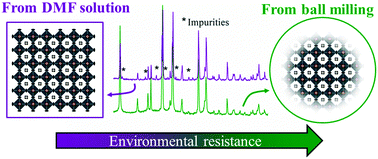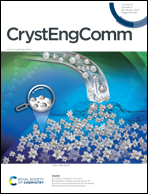Crystal structure features of CH3NH3PbI3−xBrx hybrid perovskites prepared by ball milling: a route to more stable materials†
Abstract
Hybrid organic–inorganic perovskites, MAPbX3 (MA: methylammonium, CH3–NH3+; X = halogen), are active absorption materials in the new generation of solar cells. The triiodide specimen (MAPbI3) remains the most widely studied perovskite due to its ability to absorb broadband light below its band gap of 1.6 eV, but its degradation in a humid atmosphere has remained a major obstacle for commercialization. Here we found that CH3NH3PbI3−xBrx (x = 0.0, 1.0) perovskites, prepared by ball milling, exhibit superior stability, showing no signs of degradation after several months of exposure to humid air. A synchrotron X-ray diffraction (SXRD) investigation was useful to determine some peculiar structural features that may account for the improved stability. The crystal structure was analysed to be in the I4/mcm and acentric I4cm space groups, yielding similar agreement factors. In both, the inorganic framework presents a conspicuously lower tilting effect than that observed in samples prepared by wet methods; an additional difference arises since the tetragonal structure is stable down to 140 K. The orientation of the organic MA units may play an important role in the properties, given the degrees of freedom for internal motion of MA groups within the PbX6 network. From the refined C/N positions, the MA+ units lie along the c axis with 25% probability. The structure at 140 K shows that the MA+ contribution along the c axis vanishes at this temperature. By contrast, MAPbI2Br crystallizes in the cubic phase with the space group Pm![[3 with combining macron]](https://www.rsc.org/images/entities/char_0033_0304.gif) m, also with a larger unit-cell volume than that previously described. The absence of phase transitions down to 120 K suggests that the anion disorder prevents the localization of MA units upon cooling.
m, also with a larger unit-cell volume than that previously described. The absence of phase transitions down to 120 K suggests that the anion disorder prevents the localization of MA units upon cooling.



 Please wait while we load your content...
Please wait while we load your content...